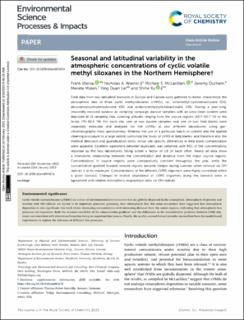| dc.contributor.author | Wania, Frank | |
| dc.contributor.author | Warner, Nicholas Alexander | |
| dc.contributor.author | McLachlan, Michael S | |
| dc.contributor.author | Durham, Jeremy | |
| dc.contributor.author | Lei, Ying Duan | |
| dc.contributor.author | Xu, Shihe | |
| dc.date.accessioned | 2023-04-11T10:27:29Z | |
| dc.date.available | 2023-04-11T10:27:29Z | |
| dc.date.created | 2023-03-16T10:38:50Z | |
| dc.date.issued | 2023 | |
| dc.identifier.citation | Environmental Science: Processes & Impacts. 2023, 25, 496-506. | en_US |
| dc.identifier.issn | 2050-7887 | |
| dc.identifier.uri | https://hdl.handle.net/11250/3062341 | |
| dc.description.abstract | Field data from two latitudinal transects in Europe and Canada were gathered to better characterize the atmospheric fate of three cyclic methylsiloxanes (cVMSs), i.e., octamethyl-cyclotetrasiloxane (D4), decamethylcyclopentasiloxane (D5) and dodecamethylcyclohexasiloxane (D6). During a year-long, seasonally resolved outdoor air sampling campaign, passive samplers with an ultra-clean sorbent were deployed at 15 sampling sites covering latitudes ranging from the source regions (43.7–50.7 °N) to the Arctic (79–82.5 °N). For each site, one of two passive samplers and one of two field blanks were separately extracted and analyzed for the cVMSs at two different laboratories using gas-chromatography-mass spectrometry. Whereas the use of a particular batch of sorbent and the applied cleaning procedure to a large extent controlled the levels of cVMS in field blanks, and therefore also the method detection and quantification limits, minor site-specific differences in field blank contamination were apparent. Excellent agreement between duplicates was obtained, with 95% of the concentrations reported by the two laboratories falling within a factor of 1.6 of each other. Nearly all data show a monotonic relationship between the concentration and distance from the major source regions. Concentrations in source regions were comparatively constant throughout the year, while the concentration gradient towards remote regions became steeper during summer when removal via OH radicals is at its maximum. Concentrations of the different cVMS oligomers were highly correlated within a given transect. Changes in relative abundance of cVMS oligomers along the transect were in agreement with relative atmospheric degradation rates via OH radicals. | en_US |
| dc.language.iso | eng | en_US |
| dc.rights | Navngivelse 4.0 Internasjonal | * |
| dc.rights.uri | http://creativecommons.org/licenses/by/4.0/deed.no | * |
| dc.title | Seasonal and latitudinal variability in the atmospheric concentrations of cyclic volatile methyl siloxanes in the Northern Hemisphere | en_US |
| dc.title.alternative | Seasonal and latitudinal variability in the atmospheric concentrations of cyclic volatile methyl siloxanes in the Northern Hemisphere | en_US |
| dc.type | Peer reviewed | en_US |
| dc.type | Journal article | en_US |
| dc.description.version | publishedVersion | en_US |
| dc.source.pagenumber | 496-506 | en_US |
| dc.source.volume | 25 | en_US |
| dc.source.journal | Environmental Science: Processes & Impacts | en_US |
| dc.identifier.doi | 10.1039/D2EM00467D | |
| dc.identifier.cristin | 2134376 | |
| cristin.ispublished | true | |
| cristin.fulltext | original | |
| cristin.fulltext | original | |
| cristin.qualitycode | 1 | |

